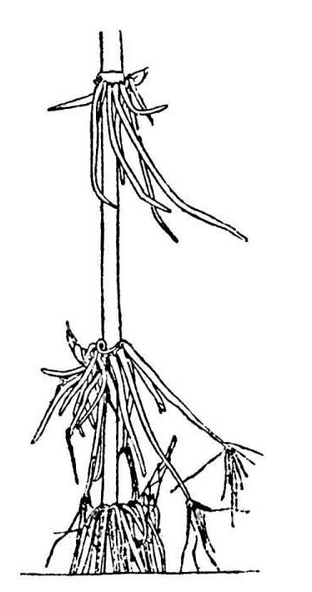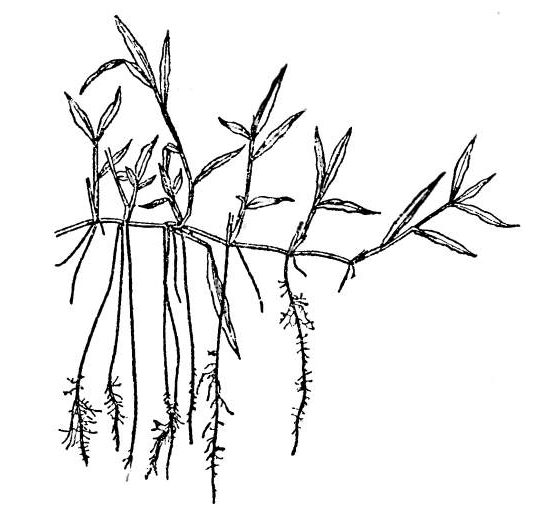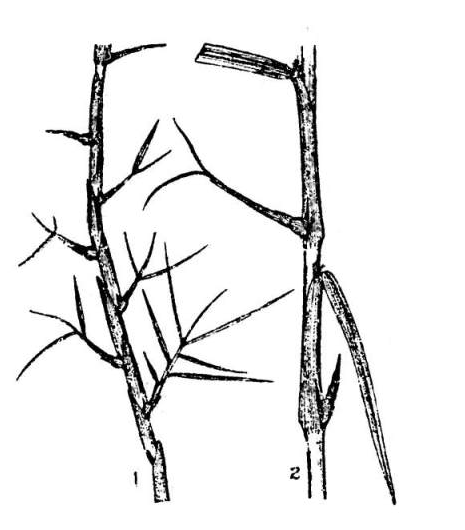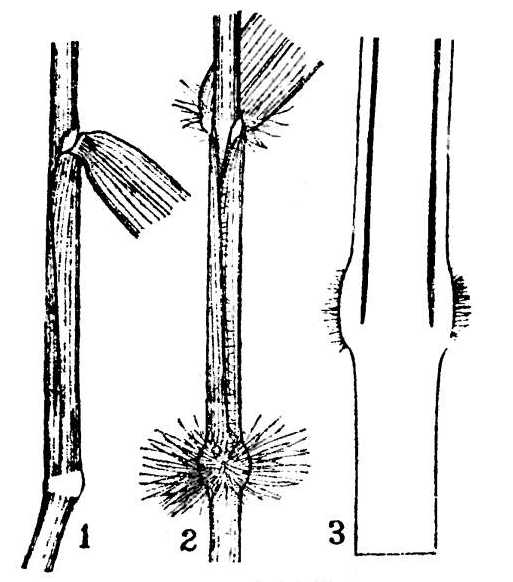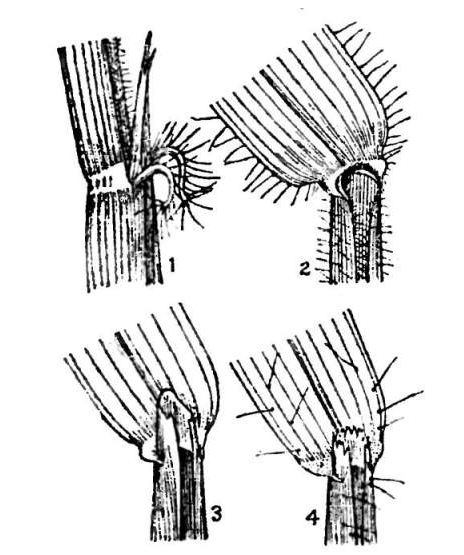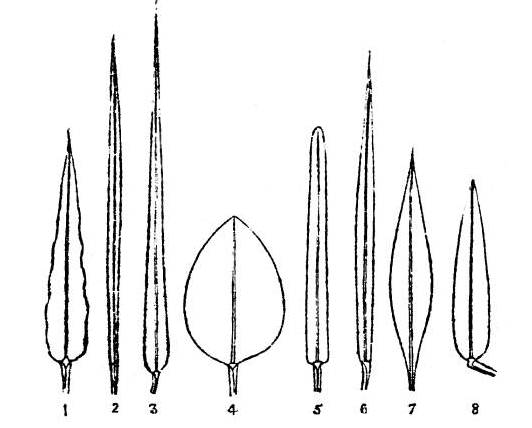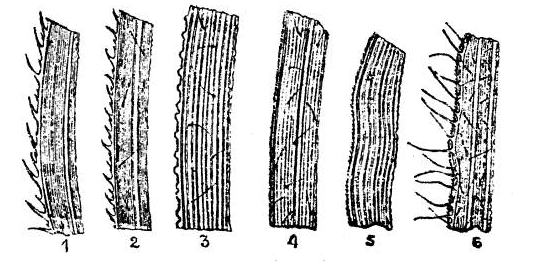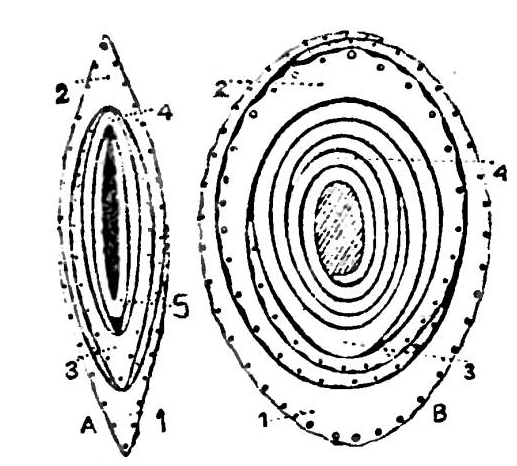A Handbook Of Some Common South Indian Grasses: 3-The Vegetative Organs
(Created page with "{| class="wikitable" |- |colspan="0"|<div style="font-size:100%"> This is a collection of articles archived for the excellence of their content.<br/>You can help by converting...") |
m (Pdewan moved page A Handbook Of Some Common South Indian Grasses: The Vegetative Organs to A Handbook Of Some Common South Indian Grasses: 3-The Vegetative Organs without leaving a redirect) |
||
| (3 intermediate revisions by one user not shown) | |||
| Line 9: | Line 9: | ||
|} | |} | ||
| − | [[Category:India | | + | [[Category:India |G]] |
| − | [[Category:Flora | | + | [[Category:Flora |G]] |
[[Category:Name|Alphabet]] | [[Category:Name|Alphabet]] | ||
[[Category:Name|Alphabet]] | [[Category:Name|Alphabet]] | ||
| Line 36: | Line 36: | ||
All the roots bear branch-roots which originate from the inner portion of the mother roots in the usual manner. The character and the extent of the development of the root-system is to a large extent dependent upon the nature of the soil and its moisture content. In light dry soils roots remain generally stunted and in [Pg 7]well drained rich soils they attain their maximum development. In clayey soils roots penetrate only to short distances. When the soil is rich and sandy roots go deeper and extend in all directions. The root-systems of most grasses are superficial and so are best adapted for surface-feeding. | All the roots bear branch-roots which originate from the inner portion of the mother roots in the usual manner. The character and the extent of the development of the root-system is to a large extent dependent upon the nature of the soil and its moisture content. In light dry soils roots remain generally stunted and in [Pg 7]well drained rich soils they attain their maximum development. In clayey soils roots penetrate only to short distances. When the soil is rich and sandy roots go deeper and extend in all directions. The root-systems of most grasses are superficial and so are best adapted for surface-feeding. | ||
| − | |||
==The shoot-system== | ==The shoot-system== | ||
Latest revision as of 18:34, 6 April 2014
This is a collection of articles archived for the excellence of their content. Readers will be able to edit existing articles and post new articles directly |
Contents |
[edit] The Vegetative Organs
Grasses vary very much in their habit. Some grasses grow erect forming tufts and others form cushions with the branches creeping along the ground. (See figs. 5 and 6.) We usually find all intermediate stages from the erect to the prostrate habit. Underground stems such as stolons and rhizomes occur in some grasses.
Grasses of one particular species generally retain the same habit but this does not always hold good. For example Tragus racemosus grows with all its branches quite prostrate in a poor, dry, open soil. If, on the other hand, this happens to grow in rich soils, or amidst other plants or grasses, it assumes an erect, somewhat tufted habit. Andropogon contortus and Andropogon pertusus are other grasses with a tendency for variation in habit. Plants that are usually small often attain large dimensions under favourable conditions of growth. Ordinarily the grass Panicum javanicum grows only to 1 or 2 feet. (See fig. 1.) The same plant in a good rich soil grew to about 6 feet in four months.
Some grasses are annual while others are perennial. It is often difficult to determine whether a certain grass is annual or perennial. But by examining the shoot-system this can be ascertained easily. In an annual all the stems and branches usually end in inflorescences and they will all be of the same year. If, on the other hand, both young leafy branches and old branches ending in inflorescences are found mixed, it must be a perennial grass. The presence of the remains of old leaves, underground stolons and rhizomes is also evidence showing the perennial character of the plant.
Grasses are eminently adapted to occupy completely large areas of land. They are also capable of very rapid extension over large areas, on account of the production of stolons, rhizomes and the formation of adventitious roots.
[edit] The root-system
The root-system of grasses is very striking in its character. In most grasses, especially in erect ones, several roots all of about the same diameter arise in a dense tuft from nearly the same level and from the lower-most nodes of the stems. The roots are all thin and fibrous in the vast majority of these plants, and they are tough and wiry only in a few cases such as in the case of the roots of Pennisetum cenchroides, P. Alopecuros, Ischæmum pilosum and Andropogon Schœnanthus.
On a close examination it will become evident that all the roots of a grass plant are adventitious. Inasmuch as the growth of the primary root is soon overtaken by other roots growing from the stem, all the roots happen to be of the same size. Roots arise from the nodes just above the insertion of the leaf, and they grow piercing the leaf-sheath.
Grasses in which stolons and prostrate branches occur have, in addition to the usual radiating crown of roots at the base, aerial roots growing out of the upper nodes of the branches and fixing them to the soil. Such roots become supporting or prop roots and are particularly conspicuous in several stout tall grasses such as Andropogon Sorghum, Zea Mays and Pennisetum typhoideum. (See figs. 8 and 9.)
All the roots bear branch-roots which originate from the inner portion of the mother roots in the usual manner. The character and the extent of the development of the root-system is to a large extent dependent upon the nature of the soil and its moisture content. In light dry soils roots remain generally stunted and in [Pg 7]well drained rich soils they attain their maximum development. In clayey soils roots penetrate only to short distances. When the soil is rich and sandy roots go deeper and extend in all directions. The root-systems of most grasses are superficial and so are best adapted for surface-feeding.
[edit] The shoot-system
The shoot-system varies with the duration of the life of the plant. In annual grasses stems are in most cases erect and even if they are not entirely so they become erect at the time of flowering. They are attached to the soil by a tuft of fibrous roots arising from the base of the stems. But in perennials in addition to erect branches, creeping branches, stolons and rhizomes may occur.
The stem is either cylindrical or compressed and consists of nodes and internodes. In most grasses the internodes are usually hollow, the cavity being lined by the remains of the original pith cells. However, there are also grasses in which the stems remain solid throughout. In many grasses the basal portions of stems are more leafy and the internodes are short, but in the upper portions the internodes become longer separating the leaves one from the other.
In young shoots the leaves grow much faster than the internodes and consequently internodes remain small, and leaves become very conspicuous. The youngest portions of the shoots are by this means always well protected by the surrounding leaf-sheaths. As soon as leaves have grown fully, the internodes begin to elongate rapidly separating the leaves. At first growth in length takes place throughout its length in the internode and when it gets older this elongation ceases. But, however, the lower portion of the internode close to the node and which is enclosed by the leaf-sheath retains its power of growth for a considerable time.
Branches arise from the axils of leaves and when a considerable number of the axillary buds, especially from the lower nodes, develop into branches the plant becomes tufted in habit. In most grasses branches grow upwards through the sheath and emerge at its mouth as aerial branches. Such branches are called intravaginal branches or stems. But in some grasses axillary buds, [Pg 9]instead of growing straight up through the sheath, pierce the leaf-sheath, come out and then they grow out as branches.
This may be seen in the underground stolons of Panicum repens and in the ordinary aerial branches of Arundo Donax. Branches that pierce through the sheaths are called extravaginal branches.
The nodes are in most cases very conspicuous and they are often found swollen. However, it must be remembered that the enlargement at the node is not due to the increase in size of the actual node, but due to growth in thickness of the base of the leaf-sheath. Nodes may be pale or coloured, glabrous, hairy or bearded with long hairs.
When the stem is erect the nodes are short and of uniform size all round. But, if the stem is bent down or tipped over by accident, the nodes begin to grow longer on the lower side until a curvature sufficient to bring the stem to the erect position is formed and then it ceases to grow.
As already noted some perennial grasses have creeping stems and stolons, while others may have rhizomes. The grass Cynodon dactylon develops several underground stolons which are covered with white scale leaves and whose terminal buds are hard and sharp so that they may be able to make their way through the soil. The rhizomes when continuous and elongated are usually sympodia formed by the lower portions of the aerial shoots. The aerial shoot comes into the air and its lower portion is continued by a branch arising from a lower leaf axil beneath the soil.
[edit] The leaf
Leaves are two-ranked and alternate, and very often they become crowded at the lower portions of the shoots so as to form basal tufts, though they are farther apart in the upper [Pg 10]portions of these shoots. Three distinct kinds of leaves are met with in grasses. First, we have the fully formed foliage leaves so characteristic of grasses. These are most conspicuous and are formed in large numbers.
The other two kinds of leaves are neither so conspicuous nor so numerous as the foliage leaves. At the base of shoots occur abortive leaves which are really rudimentary sheaths. These are called scales. The third kind of leaf is a modified structure called the prophyll or prophyllum. (See fig. 12.) It is the first leaf occurring in every branch on the side next to the main shoot and it is a two-keeled membranous structure resembling somewhat the palea found in the spikelets of grasses. The portion of the prophyll between the keels is concave due to the pressure of the main stem, while the sides beyond the keels bend forward clasping the stem.
A. A branch with its prophyllum; B. prophyllum; C. section of the prophyllum..png| Prophylla. A. A branch with its prophyllum; B. prophyllum; C. section of the prophyllum. |frame|500px]]
The ordinary foliage leaves of grasses consist of the two parts, the flat expanded upper portion called the blade and the lower part called the sheath that encircles the stem above the node from which it arises. The leaf-sheaths usually fit close to the stem, but they may also be loose or even inflated.
Though the leaf-sheath surrounds the internode like a tube, it is not a closed tube. It is really a flat structure rolled firmly round the stem with one edge overlapping the other. In most cases it is cylindrical and it may be compressed in a few cases. Occasionally it may have a prominent ridge or keel down its back. The sheath may be glabrous or hairy, smooth or striate externally, and the outer margin is often ciliate. In a few grasses the sheaths become coloured especially below or on the side exposed to the sun.
[edit] Ligule
The ligule is a structure peculiar to grasses and it varies very much. In some grasses it is a distinct membrane narrow or broad, with an even, truncate or erose margin, or finely ciliate. Very often it is only a line or fringe of hairs, whilst in some it may be entirely absent as in the leaves of Panicum colonum. When it is a membrane it may be broad and oblong, ovate and obtuse, or lanceolate and acute.
The function of the ligule is probably to facilitate the shedding of water which may run down the leaf, and thus lessen the danger of rotting of the stem which is sure to follow, if the water were to find its way into the interior of the sheath. Sometimes, in addition to the ligule, other appendages may be present in grass leaves as in Oryza sativa. Such outgrowths are called auricles or auricular outgrowths.
The leaf-blade is well developed in the foliage leaves and in most cases it follows directly on the sheath. But in bamboos and some species of Ischæmum there occurs a short petiole or stalk between the leaf-blade and the sheath. The sheath corresponds morphologically to the leaf base of a leaf of other flowering plants.
In grasses the leaf-blades usually grow more in length than in any other direction and there is no limit to the length they may attain. Some grasses have very short leaves, others very long ones. The leaf-blade in most grasses is more or less of some elongated form, such as linear, linear-lanceolate, lanceolate, etc.
In a few grasses the leaf-blade is ovate, but this is a rare condition. Therefore, in noting the general shape of the leaf-blade the relation of the length to the breadth, the amount of tapering towards the apex and base and the nature of the apex should be considered.
The veins in the leaf-blade can usually be seen on holding the leaf up to the light. All the veins run parallel. In most cases the midrib is prominent and in some cases there may be also a distinct keel. Amongst the veins running through the leaf-blade some are large and prominent, while others are small and not conspicuous. On account of this disparity, very often, ridges and furrows become prominent on the upper or lower, or on both the surfaces of the leaf-blades.
Generally the two surfaces of the leaf-blade are distinct, and they may be glabrous or hairy. In most grasses the surfaces are rough or scabrid to the touch owing to the presence of regular rows of exceedingly fine sharp pointed minute hairs.
The apex of the blade is generally sharp and pointed, acute or acuminate, or sometimes it may be drawn to a very fine point by gradual tapering. Blunt or obtuse tips are not altogether absent, but it is not a common feature. The leaf-blades in Panicum colonum and in some species of Andropogon are rounded or obtuse at the apex.
The margins of the leaf-blade are somewhat hyaline and they may be perfectly even or cut into serrations of fine teeth in various ways. (See fig. 15.) In addition to these minute teeth, there may be long or short cilia. Sometimes the margins are glandular as in Eragrostis Willdenoviana and Eragrostis major.
The base of the leaf may be narrower, broader than, or about the same as the breadth of the leaf-sheath. It may be rounded, amplexicaul or narrowed. At the base and just above the ligular region there will always be a white distinct zone in the lamina of all grasses called the collar. This collar varies in length and breadth according to the species of grass.
In young shoots all the leaf-blades are usually found folded at the terminal portions. In most cases the leaf-blade is rolled up inwards from one end to the other so that one margin is inside and the other outside. This folding is termed convolute. This is the kind of folding that is found in most grasses. However, there are some grasses such as Eleusine ægyptiaca and Chloris barbata, in which the folding is different. In these grasses the laminas are folded flat on their midribs so that each half of the blade is folded flat on the other, the inner surfaces being in contact.
The leaves are said to be conduplicate in this case. When the leaves are conduplicate the shoots are more or less compressed.


